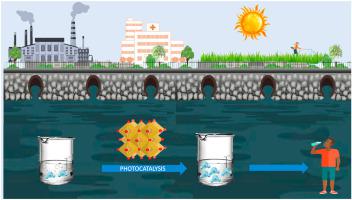Chemosphere ( IF 8.8 ) Pub Date : 2021-09-14 , DOI: 10.1016/j.chemosphere.2021.132174 V G Dileep Kumar 1 , K R Balaji 2 , R Viswanatha 3 , G Ambika 3 , R Roopa 3 , B M Basavaraja 4 , Madhu Chennabasappa 5 , C R Ravi Kumar 6 , Zhong Chen 7 , Xuan-Thanh Bui 8 , M S Santosh 9

|
Removal of the hazardous and endocrine-disrupting 2,4-dichlorophenol (2,4-DCP) from water bodies is crucial to maintain the sanctity of the ecosystem. As a low bandgap material (1.37 eV), NaBiS2 was hydrothermally prepared and used as a potential photocatalyst to degrade 2,4-DCP under visible light irradiation. NaBiS2 appeared to be highly stable and remained structurally undeterred despite thermal variations. With a surface area of 6.69 m2/g, NaBiS2 has enough surface-active sites to adsorb the reactive molecules and exhibit a significant photocatalytic activity. In alkaline pH, the adsorption of 2,4-DCP on NaBiS2 appeared to decrease whereas, the acidic and neutral environments favoured the degradation. An increase in the photocatalyst dosage enhanced the degradation efficiency from 81 to 86 %, because of higher vacant adsorbent sites and the electrostatic attraction between NaBiS2 and 2,4-DCP. The dominant scavengers degraded 2,4-DCP by forming a coordination bond between chlorine's lone pair of electrons and the vacant orbitals of bismuth, following the order hole> OH > singlet oxygen. Being non-toxic to both natural and aquatic systems, NaBiS2 exhibits antifungal properties at higher concentrations. Finally, the electron-rich NaBiS2 is an excellent electrocatalyst that effectively degrades organic pollutants and is a promising material for industrial and environmental applications.
OH > singlet oxygen. Being non-toxic to both natural and aquatic systems, NaBiS2 exhibits antifungal properties at higher concentrations. Finally, the electron-rich NaBiS2 is an excellent electrocatalyst that effectively degrades organic pollutants and is a promising material for industrial and environmental applications.
中文翻译:

使用纳米结构的 NaBiS2 可见光光降解 2,4-二氯苯酚:光催化剂的动力学、细胞毒性、抗菌和电化学研究
从水体中去除有害且会干扰内分泌的 2,4-二氯苯酚 (2,4-DCP) 对于维护生态系统的神圣性至关重要。作为一种低带隙材料 (1.37 eV),NaBiS 2被水热制备并用作潜在的光催化剂在可见光照射下降解 2,4-DCP。尽管热变化,NaBiS 2似乎高度稳定并且在结构上保持不受阻碍。NaBiS 2的表面积为6.69 m 2 /g,具有足够的表面活性位点来吸附反应分子并表现出显着的光催化活性。在碱性 pH 条件下,2,4-DCP 在 NaBiS 2上的吸附似乎减少,而酸性和中性环境有利于降解。由于更高的空吸附位点以及 NaBiS 2和 2,4-DCP之间的静电吸引力,光催化剂用量的增加将降解效率从 81% 提高到 86% 。主要清除剂通过在氯的孤对电子和铋的空轨道之间形成配位键来降解 2,4-DCP,顺序为空穴>  OH > 单线态氧。NaBiS 2对自然和水生系统均无毒,在较高浓度下表现出抗真菌特性。最后,富电子 NaBiS 2 是一种优良的电催化剂,可有效降解有机污染物,是一种很有前途的工业和环境应用材料。
OH > 单线态氧。NaBiS 2对自然和水生系统均无毒,在较高浓度下表现出抗真菌特性。最后,富电子 NaBiS 2 是一种优良的电催化剂,可有效降解有机污染物,是一种很有前途的工业和环境应用材料。



























 京公网安备 11010802027423号
京公网安备 11010802027423号